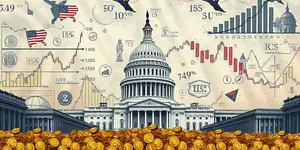
In an era defined by interconnected economies and rapid digital innovation, understanding currency exchange is vital for businesses, investors, and individuals alike. This article offers a deep dive into the forces shaping global money movements and provides actionable insights for navigating this complex landscape.
From market size and growth projections to technology-driven trends and geopolitical risks, we illuminate the key drivers behind today’s foreign exchange environment.
The global foreign exchange market continues to expand at an impressive pace, projected to grow by USD 582 billion between 2025 and 2029 at a compound annual growth rate (CAGR) of 10.6%. In 2024, the market size stood at $792.43 billion and is expected to reach $838.54 billion in 2025, reflecting a 5.8% annual increase.
Key factors fueling this growth include globalization, rising international trade volumes, accelerated urbanization, and the digital transformation of financial services. As cross-border commerce intensifies, access to competitive currency swaps becomes increasingly critical for corporates, retailers, and individual travelers.
Analysts anticipate further expansion through 2029, driven by emerging market integration and evolving regulatory frameworks that encourage foreign investment.
The Forex landscape is undergoing transformative shifts. A 24/7 global trading environment has emerged thanks to digital platforms and interconnected exchanges. Investors and businesses now have real-time access to currency swaps and hedging instruments.
Understanding these dynamics is essential for crafting resilient trading strategies and effective risk management protocols.
Advanced analytics and machine learning models are revolutionizing currency trading. Today, artificial intelligence is redefining how market participants forecast trends and execute orders. Algorithmic strategies now interpret vast data sets in real time, identifying arbitrage opportunities across multiple venues.
Meanwhile, fintech firms are deploying dynamic cross-border payment platforms, reducing transaction costs and settlement times. Retail traders and small businesses benefit from user-friendly apps that provide deep liquidity and automated hedging tools once reserved for large institutions.
Recent fund flow data reveals a marked shift in investor sentiment. In May 2025, US equity funds experienced outflows exceeding $17 billion, while international equity funds attracted inflows over $7 billion. This rotation highlights growing caution toward domestic markets amid economic uncertainty.
Alternative asset classes are also drawing significant interest. Crypto-focused vehicles, such as the iShares Bitcoin Trust ETF, have seen inflows of $46.2 billion over the past year—outpacing many traditional sector funds with organic growth rates above 50%.
Commodity funds, especially gold, faced reversals in May with combined outflows of $1.8 billion from the largest funds. Such fluctuations underscore the ebb and flow of investor appetite across risk-on and risk-off phases.
Currency volatility directly influences global property markets. A strong US dollar can deter foreign buyers in America while simultaneously enhancing the purchasing power of US investors abroad. Financing costs for international real estate deals remain highly sensitive to exchange rate swings and central bank policy shifts.
Emerging market currencies, often tied to commodity cycles, may drive bargain-hunting foreign acquisitions or prompt cautious hold strategies depending on expected currency trajectories.
Global personal wealth expanded robustly in 2024, with North America leading thanks to a stable dollar and buoyant equity valuations. The United States and China together account for over half of the world’s private wealth pool.
Notably, the cohort of individuals with assets between $1–5 million—often called EMILLIs—has quadrupled since 2000 to approximately 55 million people holding $61 trillion collectively. A significant intergenerational wealth transfer is underway, with an estimated $83 trillion expected to pass hands over the next two decades, including $9 trillion in the Americas.
In 2024 alone, over 680,000 new dollar millionaires emerged, and projections suggest an additional 5.34 million by 2029. Understanding cross-border tax implications and currency risks is crucial for preserving and growing this expanding wealth base.
Central banks and regulatory bodies exert profound influence over exchange rates through interest rate decisions, quantitative easing, and direct market interventions. Monitoring these central banks and policy decisions is fundamental for forecasting currency trajectories.
Heightened financial fragmentation in 2022 saw a more than 50% drop in certain international money movements. Future policy pivots by European and Chinese authorities could reshape capital flow patterns if successful.
The US dollar remains a safe-haven anchor, bolstered by the Fed’s tight monetary stance and global risk aversion. Market participants continue to debate potential rate cuts in late 2025.
Meanwhile, the euro faces downward pressure amid Eurozone growth concerns and political headwinds, with parity against the dollar a looming possibility. Emerging market currencies grapple with commodity price swings, trade policy shifts, and capital flow volatility.
Persistent trade tensions, US–EU policy divergences, and active conflicts in Eastern Europe and the Middle East introduce volatile geopolitical risk scenarios. Scenario planning—spanning policy divergence to sudden sanctions—remains essential for FX strategists.
Adopting a flexible, scenario-based approach helps market participants position portfolios and hedging strategies to weather unexpected shocks.
Navigating the evolving global currency landscape demands a balance of data-driven analysis, technological adoption, and strategic foresight. By staying informed on market size trends, central bank policies, and geopolitical developments, stakeholders can make sound decisions and mitigate downside risks.
Whether you are a corporate treasurer, wealth manager, or individual investor, mastering the art and science of foreign exchange is now more important than ever. Embrace innovation, monitor global flows, and remain agile to thrive in this dynamic environment.
References













